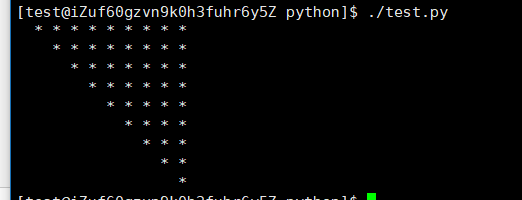1 . while 循环
while condition: statement1 statement2
例子:
#! /usr/bin/python n = 0 while n < 5 : print (n) n = n + 1 [test@iZuf60gzvn9k0h3fuhr6y5Z python]$ ./test.py 0 1 2 3 4
斐波那契数列
如下被以递归的方法定义:F(1)=1,F(2)=1, F(n)=F(n-1)+F(n-2)(n>=2,n∈N* 这个数列从第3项开始,每一项都等于前两项之和
#! /usr/bin/python a,b = 0, 1 while b < 100 : #print (b) print (b,end=' ') a , b = b , a + b print ()
a , b = b , a + b 先计算在赋值 a=b b=(a+b)
print () 默认换号 ,可以更改end的类型 end =' '
乘法表
打印10以内的乘法表
#! /usr/bin/python
i = 1
print ("-"*50)
#字符串若是乘上整数 n,将返回由 n 个此字符串拼接起来的新字符串
while i < 11 :
n = 1
while n < 11 :
print ("{:4d}".format(i * n), end = ' ')
#print ("{:x>4d}".format(i * n), end = ' ')
#print ("{:x<4d}".format(i * n), end = ' ')
#:4d 左边补空格 >4d 左边补x x<4d 右边补x
n = n + 1
print ()
i = i + 1

打印星号
#! /usr/bin/python
n = '* '
i = 1
while i < 10 :
x = n * (10 - i)
y = i * ' '
print (y + x)
i = i + 1

正等登各式各样的
2.列表
中刮号之间一列用逗号分隔的值,列表中的原始不一定事同一类型的值。
a=[1,'zw','hello','wd']
有索引 ,可以为负数 -4~3
a[0] = 1 a[-1]='wd'
切片 用:隔开 前闭后开
>>> a[1:3] ['zw', 'hello'] >>> a[:3] [1, 'zw', 'hello'] >>> a[2:] ['hello', 'wd'] >>> a[2:-1] ['hello'] >>> a[-1:-1] [] >>> a[-1:1] [] >>> a[1:-1] ['zw', 'hello']
Python 能够优雅地处理那些没有意义的切片索引:一个过大的索引值(即大于列表实际长度)将被列表实际长度所代替,当上边界比下边界大时(即切片左值大于右值)就返回空列表:
设置步长 ::
>>> a[0::2] [1, 'hello'] >>> a[1::2] ['zw', 'wd'] >>> a[1::3] ['zw'] >>> a[0::3] [1, 'wd'] >>>
列表链接
>>> a+['YOU',999,88] [1, 'zw', 'hello', 'wd', 'YOU', 999, 88]
列表修改
>>> a[0]=4 >>> a [4, 'zw', 'hello', 'wd'] >>> a [4, 'wd', 'a', 'b', 'c', 'd'] >>> a[2:4]=['5'] #改变列表 少元素默认删除 >>> a [4, 'wd', '5', 'c', 'd'] >>> a[2:4]=[] #空列表删除 >>> a [4, 'wd', 'd']>>> a[:]=[] >>> a [] >>>
检查某个值是否在列表中
>>> a=['a','b','c','d','e'] >>> 'c' in a True >>> 'f' in a False >>> len(a) 5 # 判断列表是否为空 if list_name: # 列表不为空 pass else: # 列表为空 pass
3.for
通过 for 语句我们可以使用 for 循环。Python 里的 for 循环与 C 语言中的不同。这里的 for 循环遍历任何序列(比如列表和字符串)中的每一个元素。下面给出示例:
#! /usr/bin/python a = [1 ,2 ,3, 4, 5, 6] for i in a : print (i ,end='|') print() for i in a[::2]: print (i,end='|') print() [test@iZuf60gzvn9k0h3fuhr6y5Z python]$ ./test.py 1|2|3|4|5|6| 1|3|5|
range()
for i in range(0,10,3): print (i) 0 3 6 9
4.continue
while True : a = int ( input("please input an integer:")) if a < 0 : continue elif a == 0 : break else : print ('--')




 本文详细介绍了Python的基础语法,包括while循环、列表操作、for循环及continue的使用方法,并提供了多个实用示例。
本文详细介绍了Python的基础语法,包括while循环、列表操作、for循环及continue的使用方法,并提供了多个实用示例。
















 4万+
4万+

 被折叠的 条评论
为什么被折叠?
被折叠的 条评论
为什么被折叠?








